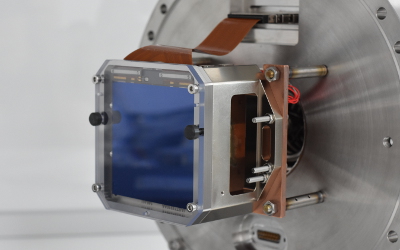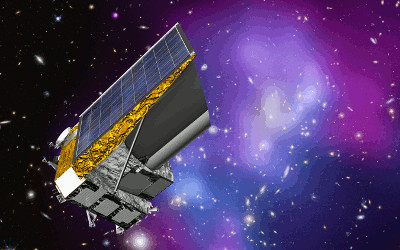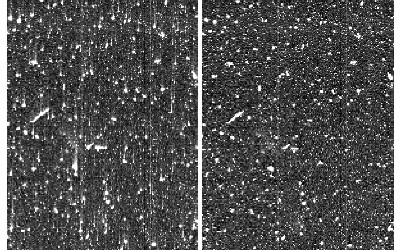Capturing the secrets of the Universe

Dr David Hall discusses The Open University's (OU) Centre for Electronic Imaging’s pioneering work on technologies that allow us to explore even the darkest corners of the cosmos and are making the UK a leader in space research.
Space has intrigued and inspired humanity since the dawn of civilisation. It has taught us so much about the nature and origins of existence. But we’ve still barely scratched the surface. From dark matter to life on other planets, our Universe holds an unfathomable number of secrets. What we know for sure is that we don’t know enough.
Science gives us unlimited opportunities to theorise about why galaxies, stars and planets are the way they are. Nonetheless, to test our hypotheses, we have to take a ‘look’. During the past three decades, space-based imaging instruments, such as the ubiquitous Hubble Space Telescope, and the immensely detailed pictures they take, have changed our fundamental understanding of the Universe. Still, while high-definition images of the cosmos are just a google search away for most of us, we should never take the extraordinary technological achievement that underpins them for granted. Nor should we forget that each answer they give us sparks new questions and an ever greater need for even more sophisticated and accurate imaging technologies.
Applied collaborative research with industry partners
My colleagues and I from the OU’s Centre for Electronic Imaging (CEI) are committed to developing advanced image sensor technologies to meet these challenges. Led by Professor Andrew Holland, the CEI is a collaboration between the OU and innovative technology company Teledyne e2v. Since its formation in 2004, the CEI’s growing community of now more than 30 academics, researchers and PhD students, has developed tailored image sensor technologies for 14 international European, US and Indian agency-led space missions.

The CEI has pioneered advances in Charged-Coupled Device (CCD) and Complementary Metal-Oxide Semiconductor (CMOS) light-capturing silicon sensors. By combining these sensors to form large imaging arrays, we can create extremely sensitive imaging technology to explore even the darkest corners of the Universe. The CEI was involved in the instrument built for the European Space Agency’s (ESA) Gaia mission to measure one billion stars in our galaxy and beyond (launched 2013), for example, which had the largest camera ever launched into space. Gaia’s one metre-wide image sensor was almost 30 times larger than those found in modern smartphone cameras, contained more than 100 CCDs, and captured 1000 megapixel (1,000,000,000 pixels) images.
The CEI research has also developed new CMOS image sensors that testing demonstrates are 10-times more efficient at near-infrared light wavelengths. Teledyne e2v and its CMOS imaging subsidiary, Teledyne AnaFocus are currently exploring diverse medical and scientific imaging applications for the technology.
Science in the harsh environment of space
Designing and building imaging instruments in the lab is one thing. But ensuring they can work – without maintenance and consistently for the duration of a three, five or 10-year mission – in the harsh environment of space is another thing entirely. The number one cause of damage to silicon sensors isn’t the vibrations or extreme launch temperatures but radiation. High energy protons, in particular, can be an imaging instruments’ worst enemy. Hurtling through the vacuum of space at close to the speed of light, when these positively charged subatomic particles hit silicon sensors, they can knock their atoms out of place. These misaligned atoms then temporarily ‘trap’ the signals the device generates before releasing them later, which can wreak havoc on the signals telescopes send back to earth and lead to images that appear heavily smeared.
On especially sensitive devices such as the ESA’s Euclid mission’s VIS instrument, which will map the Universe’s geometry, dark energy and dark matter, this smearing can massively distort images. In some cases, it can make subtle changes to shapes appear 300 times larger than they are. This level of interference makes it impossible to do science without correcting the damage in the images. The correction required for Euclid VIS is around ten times stronger than that currently used for Hubble.
Radiation damage is inevitable, but we can minimise its impact
We’ve developed new methods to enhance instruments’ radiation shielding to protect silicon sensors better. Still, damage is inevitable. So, we’ve also developed techniques to detect a single silicon atom being out of place to create early warning systems for mission operators to detect damage in orbit in real-time and adjust how they use instruments to minimise the impact. Euclid will be the first mission to use this new system when it launches very soon.

We’ve also used our research to significantly minimise this damage’s impact on operational telescopes' performance. For example, we’ve developed a pioneering new technique called ‘trap pumping’. This method involves shuffling signals back and forth thousands of times - at just the right speed - to measure when ‘traps’ in damaged silicon sensors release the captured signal and clean up smeared images back in the lab, locating the position of the damage accurate to within a few thousandths of a millimetre. This innovative approach has significantly enhanced the radiation resilience of CCDs in Euclid and other ESA missions such as SMILE (the Solar wind Magnetosphere Ionosphere Link Explorer) to understand the dangers of space weather. NASA is also employing trap pumping on the Nancy Grace Roman Space Telescope.

Resilient at minus 100 degrees Celsius
CEI has spearheaded a brand new approach to testing space imaging instruments for radiation resilience. By cooling devices to minus 100 degrees Celsius in cryogenic chambers and keeping them at this temperature before irradiating and operating them for weeks or months on earth, we can more accurately stress test how they are likely to perform in space during their operational life. Together with our new trap pumping technique, this novel way of testing devices in the conditions they will experience in the cold vacuum of space helps us find new ways to operate the device to maximise performance and minimise the impact of the radiation damage. This approach has allowed us to improve the performance of the Euclid VIS instrument by 20%, equivalent to extending its lifespan from five to six years and effectively creating more valuable time for scientific discovery for no additional cost.
An academia and industry collaboration example to follow
The OU’s partnership with Teledyne e2v demonstrates how well universities and private sector companies can work together to drive innovation, create new products, benefit the economy, and enhance the UK’s international research reputation. This collaboration has supported hundreds of jobs and generated tens of millions of pounds across the technology supply chain. Our work with Teledyne e2v has also created opportunities to support local SMEs, such as the team at Northampton-based innovative imaging solutions firm XCAM, with whom we’re developing the next generation of X-ray cameras. All this before you consider the way this work has already transformed space exploration and will continue to do so. Like the Universe itself, the opportunities are infinite.
You may also be interested in:
Written by: Dr David Hall, Lecturer in Physical Sciences